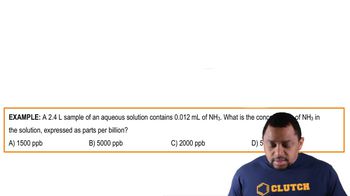Air pollution in the Mexico City metropolitan area is among the worst in the world. The concentration of ozone in Mexico City has been measured at 441 ppb (0.441 ppm). Mexico City sits at an altitude of 7400 feet, which means its atmospheric pressure is only 0.67 atm. (b) How many ozone molecules are in 1.0 L of air in Mexico City? Assume T = 25 °C.
Ch.18 - Chemistry of the Environment
Chapter 18, Problem 16
(b) What is the concentration of neon in the atmosphere in molecules per liter, assuming an atmospheric pressure of 730 torr and a temperature of 296 K?
 Verified step by step guidance
Verified step by step guidance1
Step 1: Convert the atmospheric pressure from torr to atm. Use the conversion factor: 1 atm = 760 torr.
Step 2: Use the Ideal Gas Law equation, PV = nRT, to find the number of moles of neon per liter. Here, P is the pressure in atm, V is the volume in liters (1 L for simplicity), n is the number of moles, R is the ideal gas constant (0.0821 L·atm/mol·K), and T is the temperature in Kelvin.
Step 3: Rearrange the Ideal Gas Law equation to solve for n (moles of gas): n = PV / RT.
Step 4: Calculate the number of moles of neon using the values from Step 1 and the given temperature.
Step 5: Convert the moles of neon to molecules using Avogadro's number (6.022 x 10^23 molecules/mol) to find the concentration of neon in molecules per liter.
Key Concepts
Here are the essential concepts you must grasp in order to answer the question correctly.
Ideal Gas Law
The Ideal Gas Law is a fundamental equation in chemistry that relates the pressure, volume, temperature, and number of moles of a gas. It is expressed as PV = nRT, where P is pressure, V is volume, n is the number of moles, R is the ideal gas constant, and T is temperature in Kelvin. This law allows us to calculate the concentration of gases under specific conditions.
Recommended video:
Guided course

Ideal Gas Law Formula
Molar Volume of a Gas
At standard temperature and pressure (STP), one mole of an ideal gas occupies 22.4 liters. However, under different conditions, such as varying pressure and temperature, the volume occupied by a mole of gas changes. Understanding how to adjust for these conditions is crucial for calculating the concentration of gases in the atmosphere.
Recommended video:
Guided course

The Ideal Gas Law: Molar Mass
Concentration in Molecules per Liter
Concentration can be expressed in various units, including moles per liter (M) or molecules per liter. To convert from moles to molecules, Avogadro's number (approximately 6.022 x 10^23 molecules per mole) is used. This conversion is essential for determining the number of gas molecules present in a given volume, particularly in atmospheric chemistry.
Recommended video:
Guided course

Parts per Billion Example
Related Practice
Textbook Question
4
views
Textbook Question
From the data in Table 18.1, calculate the partial pressures of carbon dioxide and argon when the total atmospheric pressure is 1.05 bar.
Textbook Question
The dissociation energy of a carbon-bromine bond is typically about 276 kJ/mol. (a) What is the maximum wavelength of photons that can cause C-Br bond dissociation?
2
views
Textbook Question
The dissociation energy of a carbon-bromine bond is typically about 276 kJ/mol. (b) Which kind of electromagnetic radiation—ultraviolet, visible, or infrared—does the wavelength you calculated in part (a) correspond to?
